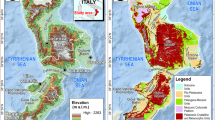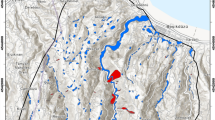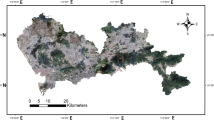Abstract
In the last years, statistically based models (such as Logistic Regression) have been frequently used for evaluating the probability of landslide occurrence over large areas. In the case of Rome, over the years, more than 348 landslides have been recorded throughout the city. For this reason, in this study, we implemented and evaluated three main validation criteria of logistic regression to assess the rainfall-induced landslide susceptibility in a specific area of the city of Rome. Through the evaluation of the predictive performances, the best model has been identified and the results were also compared with those obtained in similar case studies.
Access this chapter
Tax calculation will be finalised at checkout
Purchases are for personal use only
Similar content being viewed by others
References
Alessi D, Bozzano F, Di Lisa A, Esposito C, Fantini A, Loffredo A, Martino S, Mele F, Moretto S, Noviello A, Prestininzi A, Sarandrea P, Scarascia Mugnozza G, Schiliro L, Varone C (2014) Geological risk in large cities: the landslides triggered in the city of Rome (Italy) by the rainfall of 31 January–2 February. Italia J Eng Geol Environ:15–34. https://doi.org/10.4408/IJEGE.2014-01-0-02
Ayalew L, Yamagishi H (2005) The application of GIS-based logistic regression for landslide susceptibility mapping in the Kakuda-Yahiko Mountains, Central Japan. Geomorphology 65:15–31
Bozzano F, Salvatore M, Priori M (2006) Natural and man-made induced stress evolution of slope: the Monte Mario hill of Rome. Environ Geol 50:505–524. https://doi.org/10.1007/s00254-006-0228-y
Budimir MEA, Atkinson PM, Lewis HG (2015) A systematic review of landslide probability mapping using logistic regression. Landslides 12:419–436. https://doi.org/10.1007/s10346-014-0550-5
Carrara A (1983) Multivariate models for landslide hazard evaluation. J Int Assoc Math Geol 15(3):403–426
Carrara A, Crosta G, Frattini P (2008) Comparing models of debris-flow susceptibility in the alpine environment. Geomorphology 94:353–378. https://doi.org/10.1016/j.geomorph.2006.10.033
Chauhan S, Sharma M, Arora MK (2010) Landslide susceptibility zonation of the Chamoli region, Garhwal Himalayas, using logistic regression model. Landslides 7:411–423. https://doi.org/10.1007/s10346-010-0202-3
Chung CF, Fabbri AG (1999) Probabilistic prediction models for landslide hazard mapping. Photogramm Eng Remote Sens 65–12:1389–1399
Chung CF, Fabbri AG (2003) Validation of spatial prediction models for landslide hazard mapping. Nat Hazards 30(3):451–472
Corominas J, van Westen CJ, Frattini P, Cascini L, Malet J-P, Fotopoulou S, Catani S, Van Den Eeckhaut M, Mavrouli O, Agliardi F, Pitilakis K, Winter MG, Pastor M, Ferlisi S, Tofani V, Hervas J, Smith JT (2014) Recommendations for the quantitative analysis of landslide risk. Bull Eng Geol Environ 73:209–263. https://doi.org/10.1007/s10064-013-0538-8
Cruden DM, Varnes DJ (1996) Landslide Types and Processes. In: Turner AK, Shuster RL (eds) Landslide: investigation and Mitigation, Special Report, Transportation Research Board, National Academy of Sciences, 247. National Academy Press, Washington, DC, pp 36–75
Del Monte M, D’orefice M, Luberti GM, Marini R, Pica A, Vergari F (2016) Geomorphological classification of urban landscapes: the case study of Rome (Italy). J Maps 12(Suppl 1):178–189. https://doi.org/10.1080/17445647.2016.1187977
Devkota CK, Regmi DA, Pourghasemi HR, Yoshida K, Pradhan B, Ryu IC, Dhital MR, Althuwaynee OF (2013) Landslide susceptibility mapping using certainty factor, index of entropy and logistic regression models in GIS and their comparison at Mugling–Narayanghat road section in Nepal Himalaya. Nat Hazards 65:135–165. https://doi.org/10.1007/s11069-012-0347-6
Frattini P, Crosta GB, Carrara A (2010) Techniques for evaluating the performance of landslide susceptibility models. Eng Geol 111(1–4):62–72. https://doi.org/10.1016/j.enggeo.2009.12.004
Funiciello R, Giordano G (2008) La nuova Carta Geologica di Roma: litostratigrafia e organizzazione stratigrafica. Mem Descr Carta Geol D’It 80(1):39–85, 22 figg., Firenze
Glade T (2003) Landslide occurrence as a response to land use change: review of evidence from New Zealand. Catena 50(3–41):297–314
Guzzetti F, Carrara A, Cardinali M, Reichenbach P (1999) Landslide hazard evaluation: a review of current techniques and their application in a multi-scale study, Central Italy. Geomorphology 31:181–216
Guzzetti F, Reichenbach P, Cardinali M, Galli M, Ardizzone F (2006) Probability landslide hazard assessment at the basin scale. Geomorphology 81:272–299
ISTAT (2011) Istituto Nazionale di Statistica (eng. National Institute of Statistics) of Italy
Lin L, Lin Q, Wang Y (2017) Landslide susceptibility mapping on a global scale using the method of logistic regression. Nat Hazards Earth Syst Sci 17:1411–1424. https://doi.org/10.5194/nhess-17-1411-2017
Mărgărint MC, Grozavu A, Patriche CV (2013) Assessing the spatial variability of coefficients of landslide predictors in different regions of Romania using logistic regression. Nat Hazards Earth Syst Sci 13:3339–3355. https://doi.org/10.5194/nhess-13-3339-2013
Mathew J, Jha VK, Rawat GS (2007) Application of binary logistic regression analysis and its validation for landslide susceptibility mapping in part of Garhwal Himalaya, India. Int J Remote Sens 28(10):2257–2275. https://doi.org/10.1080/01431160600928583
Ohlmacher GC, Davis JC (2003) Using multiple logistic regression and GIS technology to predict landslide hazard in Northeast Kansas, USA. J Eng Geol:331–343. https://doi.org/10.1016/S0013-7952(03)00069-3
Park DW, Nikhil NV, Lee SR (2013) Landslide and debris flow susceptibility zonation using TRIGRS for 2011 Seoul landslide event. Nat Hazards Earth Syst Sci 13:2833–2849. https://doi.org/10.5194/nhess-13-2833-2013
Reichenbach P, Rossi M, Malamud BD, Mihir M, Guzzetti F (2018) A review of statistically-based landslide susceptibility models. Earth Sci Rev 180:60–91
Schilirò L, Cevasco A, Esposito C, Scarascia MG (2018) Shallow landslide initiation on terraced slopes: inferences from a physically based approach. Geomatics Nat Hazards Risk 9(1):295–324. https://doi.org/10.1080/19475705.2018.1430066
Trigila A, Iadanza C, Esposito C, Scarascia MG (2015) Comparison of logistic regression and random forests techniques for shallow landslide susceptibility assessment in Giampilieri (NE Sicily, Italy). Geomorphology 249:119–136. https://doi.org/10.1016/j.geomorph.2015.06.001
Van Den Eeckhaut M, Hervás J, Jaedicke C, Malet JP, Montanarella M, Nadim F (2012) Statistical modelling of Europe-wide landslide susceptibility using limited landslide inventory data. Landslides 9:357–369. https://doi.org/10.1007/s10346-011-0299-z
Varnes DJ (1978) Slope movement types and processes. In: Schuster RL, Krizek RJ (eds) Landslides: analysis and control, special report 176. Transportation research Board, national research council, Washington, DC, pp 11–33
Ventriglia U (2002) Geologia del territorio Comune di Roma. A cura del Servizio Geologico, Difesa del Suolo – Provincia di Roma, 809 pagg., 13 tavole fuori testo.
Wang L-J, Sawada K, Moriguchi S (2013) Landslide susceptibility analysis with logistic regression model based on FCM sampling strategy. Comput Geosci 57:81–92. https://doi.org/10.1016/j.cageo.2013.04.006
Author information
Authors and Affiliations
Corresponding author
Editor information
Editors and Affiliations
Rights and permissions
Copyright information
© 2020 Springer Nature Switzerland AG
About this chapter
Cite this chapter
Djueyep, G.P., Esposito, C., Schilirò, L., Bozzano, F. (2020). Validation of a Shallow Landslide Susceptibility Analysis Through a Real Case Study: An Example of Application in Rome (Italy). In: De Maio, M., Tiwari, A. (eds) Applied Geology. Springer, Cham. https://doi.org/10.1007/978-3-030-43953-8_16
Download citation
DOI: https://doi.org/10.1007/978-3-030-43953-8_16
Published:
Publisher Name: Springer, Cham
Print ISBN: 978-3-030-43952-1
Online ISBN: 978-3-030-43953-8
eBook Packages: Earth and Environmental ScienceEarth and Environmental Science (R0)




